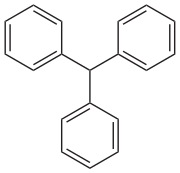
| |

| |
| Names | |
|---|---|
| Preferred IUPAC name
1,1′,1″-Methanetriyltribenzene | |
| Other names
Triphenylmethane
1,1′,1″-Methylidynetrisbenzene | |
| Identifiers | |
3D model (JSmol)
|
|
| ChEBI | |
| ChemSpider | |
| ECHA InfoCard | 100.007.524 |
| EC Number |
|
PubChem CID
|
|
| UNII | |
CompTox Dashboard (EPA)
|
|
| |
| |
| Properties | |
| C19H16 | |
| Molar mass | 244.337 g·mol−1 |
| Appearance | Colorless solid |
| Density | 1.014 g/cm3 |
| Melting point | 92 to 94 °C (198 to 201 °F; 365 to 367 K) |
| Boiling point | 359 °C (678 °F; 632 K) |
| Insoluble | |
| Solubility | Soluble in dioxane[1] and hexane |
| Acidity (pKa) | 33.3 |
| −165.6×10−6 cm3/mol | |
| Hazards | |
| GHS labelling: | |

| |
| Warning | |
| H315, H319, H335 | |
| Safety data sheet (SDS) | External MSDS |
Except where otherwise noted, data are given for materials in their standard state (at 25 °C [77 °F], 100 kPa).
| |
Triphenylmethane or triphenyl methane (sometimes also known as Tritan), is the hydrocarbon with the formula (C6H5)3CH. This colorless solid is soluble in nonpolar organic solvents and not in water. Triphenylmethane is the basic skeleton of many synthetic dyes called triarylmethane dyes, many of them are pH indicators, and some display fluorescence. A trityl group in organic chemistry is a triphenylmethyl group Ph3C, e.g. triphenylmethyl chloride (trityl chloride) and the triphenylmethyl radical (trityl radical).